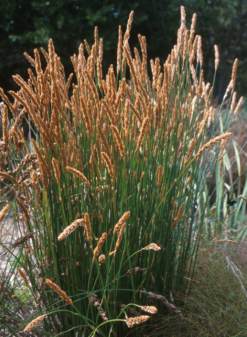Elegia fistulosa
Elegia fistulosa Kunth
Family: Restionaceae
Common names: Hollow Reed, Pypriet
Introduction
Elegia fistulosa is a tall, grass-like plant, decorative nearly all year round, low-maintenance, easy and rewarding to grow.

Description
Description
It belongs to the Restionaceae, a large family of about 400 species, nearly 350 of which occur only in South Africa. This particular species is neat, tufted and upright; with long slender reed-like stems up to 1 metre high. The species name of fistulosa refers to the fact that these stems are hollow, a fistula being a shepherd's pipe, a tube, a natural pipe or spout. Every stem has an inflorescence, which is at least 10 centimetres long and has small side stems, each with about 15 flowers, which are nearly hidden by large golden brown bracts.
All restios are dioecious, i.e. the male and female flowers are on different plants. The female plants have quite small, insignificant flowers while the male flower stems are more prominent and much larger. Although the main flowering period is from September to the end of December, the bracts are retained and remain showy for almost a year.


Distribution and habitat
Distribution description
Elegia fistulosa is a widespread and common species, occurring all along the southern coastal plateaux and mountain ranges in South Africa, from Malmesbury to Port Elizabeth. In nature, the plants nearly always grow in damp places, or with their roots in running water.
Ecology
Ecology
As with all other restios, Elegia fistulosa is wind pollinated, although at the height of the flowering season, bees do visit the male plants and collect the pollen. The seeds ripen during the year and most seed can be expected a year after flowering. The plants renew themselves every year by producing a new crop of stems in the centre of the plant. During the second year these stems grow to maturity, flower and produce seed and slowly die off during the third year.
Growing Elegia fistulosa
Grow
Elegia fistulosa is very easy to grow and is pest free. It can be used as a perennial in a small garden or a courtyard, or as a group in a larger planting. It can also be grown in a large pot. These plants are best planted in full sun, in very well drained soil and in a spot that has free air-circulation. Here they will reward the gardener by being very healthy, low maintenance plants, providing an almost year-round display. They can be grown in hot, dry areas, provided they are watered several times a week, but do not do well if planted too near a hot wall. The plants do not like frost and will not survive if the roots are frozen. They require temperatures above 4ºC / 40ºF / Zone 11. Both the male and female inflorescences are long lasting and can be used in flower arrangements.
Elegia fistulosa is best propagated by seed and while it has a very low rate of germination, this is much improved by giving the seed a smoke treatment. This can be done by placing the seed trays in a small tent and pumping smoke into the tent, allowing the smoke to settle and then watering the seed trays, or by soaking the seed in a commercially available solution of smoke and hormones, the Instant Smoke Plus Seed Primer. Once the seed has germinated, the plants grow fast and can produce inflorescences within a year. In contrast to other fast growing restios, Elegia fistulosa plants grow well for at least five to seven years and do not have to be replaced soon.
References
- Dorrat-Haaksma, E.& Linder, H. P., 2000, Restios of the Fynbos, The Botanical Society of South Africa.L
- Linder, H.P., 1985, A conspectus of the African Species of Restionaceae. Bothalia 15 : 3-4.
- Linder, H.P., 1991, A review of the Southern African Restionaceae, Contributions from the Bolus Herbarium, Number 13.
- Goldblatt, P. & Manning, J., 2000, Cape Plants - A Conspectus of the Cape Flora of South Africa. Strelitzia 9, National Botanical Institute, Pretoria.
- Brown, N. Jamieson, H. & Botha, P., 1998, Grow Restios, Kirstenbosch Gardening Series, National Botanical Institute, Cape Town.
Credits
Hanneke Jamieson
Kirstenbosch National Botanical Garden
November 2001
Plant Attributes:
Plant Type: Restio
SA Distribution: Eastern Cape, Western Cape
Soil type: Sandy, Clay, Loam
Flowering season: Spring, Early Summer, Late Summer
PH: Acid, Neutral
Flower colour: Brown
Aspect: Full Sun
Gardening skill: Easy
Special Features:
Horticultural zones







Rate this article
Article well written and informative
Rate this plant
Is this an interesting plant?
Login to add your Comment
Back to topNot registered yet? Click here to register.